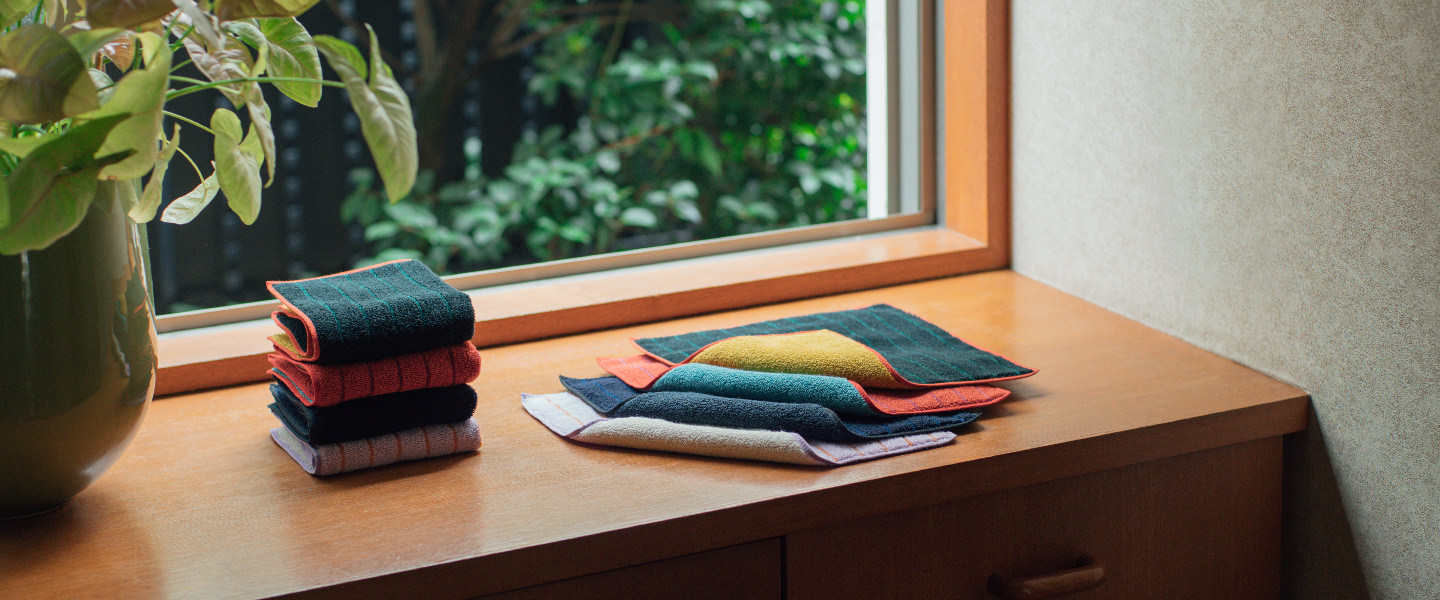
Color-change by shearing
Even design color-change
and color-depth.
The GRAPHIC LINE series pursues beauty by making full use of Fujitaka's technological capabilities.
The feature of #03 is “Shearing” with unevenness.
Towel shearing is a technique in which the ends of piles in a loop shape are trimmed and smoothed.
In this #03, only the thin stripe-pattern parts are woven with grandrelle yarn made by twisting two colors of yarn.
In addition, only the piles of stripes are sheared to create a color gradient.
The effect of shearing mottled threads gives a beautiful gradation to the color of the stripes that you won't tire of looking at.
Both the front and
back are equally beautiful
with both sides claiming the lead.
Another focus of #03 is to be reversible.
Like the handkerchief in the photo, the front and back colors are contrasted and either combination is designed to pleasantly surprise.
So, you can use assign the lead to either character depending on your mood of the day.
They are woven with twin yarn to make the texture on both sides soft and comfortable.
There are 4 patterns of design.
A variety of color combinations are available, so you can find your favorite handkerchief regardless of age or gender.
It is also recommended as a gift for the fashion conscious.
Product information
Tips for using our towels
Our towels are made of delicate fabric.
Here are some tips for using them comfortably,
over a long period.
- First Use
-
- New towels are nicer to use if you wash them once.
- At first the towels may shed some fine fluff, but this will stop after several washes.
※ This does not include towels with zero-twist yarn (non-intertwined threads) - New towels may fade in color if they are stored in that state for a long number of years, so please wash them as soon as you get them.
- Washing Instructions
-
- Wash towels so that they are immersed in plenty of water.
- Washing machines with a drum only spray a small amount of water onto the laundry to remove the dirt, which risks the pile hardening. If you are using a drum-type machine then it's better to use the dryer feature to finish off the towels and plumpen the pile. Select a wash setting that pumps through as much water as possible.
- Please note that there is a risk of the pile being caught if you wash towels with things that have zips or velcro.
- Choosing a washing detergent
-
- Please avoid using detergents with whitening fluorescents or chlorine bleach, as there is a risk of discoloration.
- Please refrain from using fabric softener as this may damage the absorbency of the towel. We only recommend using it for towels that have hardened with age.
- Drying
-
- Leaving the water to evaporate from towels over a long period of time causes the pile to collapse and harden.
- Please dry towels quickly, as the pile will collapse and harden if the towels are left as is after the water has evaporated.
- Dry in a well-ventilated shaded area as strong sunlight causes fading and makes the towels hard.
- Please note that leaving towels wet can cause odors, fungi and bacteria to form.
- To sustain the volume
-
- When drying your towel after it has been washed, please take both ends, shake it with a snap, pull it into shape and leave to dry to ensure that you always have a soft, plump towel to use. Shaking it in the air makes the fibers stand up and ensures a fluffy finish.
- Storage
-
- Try not to crush towels as far as possible and store them in a plumped-up state.
- Store in a well-ventilated place, as towels will absorb moisture.
- If the pile ends up snagged
-
- Our towels are made of delicate fabric, so the pile may end up getting snagged on a nail etc.
- If any of the pile is sticking out, trim it at the base with a pair of scissors. In this event, please be careful not to damage the base of the fabric.
- If the hem or the selvedge ends up frayed, you can stop any further fraying by going over it with a sewing machine.